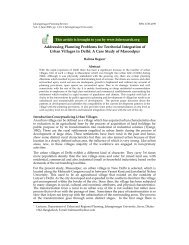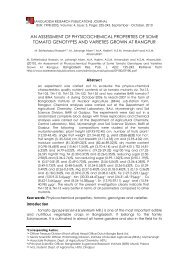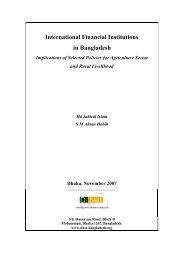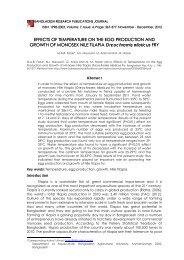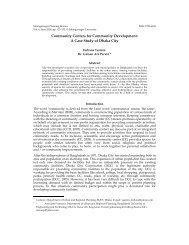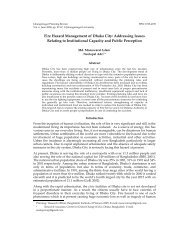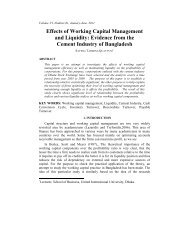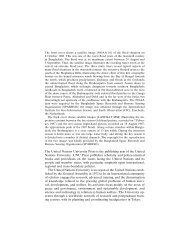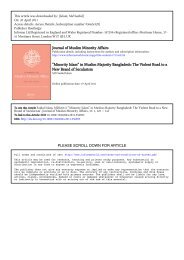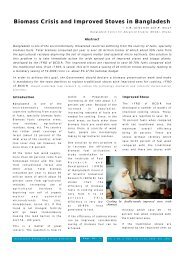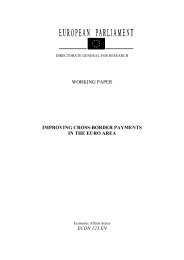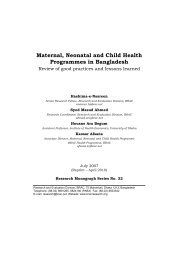Gender issue in climate change discourse - Bangladesh Online ...
Gender issue in climate change discourse - Bangladesh Online ...
Gender issue in climate change discourse - Bangladesh Online ...
Create successful ePaper yourself
Turn your PDF publications into a flip-book with our unique Google optimized e-Paper software.
elationship between man and women <strong>in</strong> case of different responsibilities that the society assigned. Inacademia, gender refers to the social roles and relations between women and men which <strong>in</strong>cludedifferent responsibilities of women and men <strong>in</strong> a given culture and location. Where as, gender equalityrefers to “the equal rights, responsibilities and opportunities of women and men and girls and boys.Equality between men and women is seen both as a human rights <strong>issue</strong> and as a precondition for, and<strong>in</strong>dicator of, susta<strong>in</strong>able people-cantered development” (UNDP 2009). <strong>Gender</strong> analysis, however, isclosely related to power analysis, and recognised as an important conceptual tool <strong>in</strong> address<strong>in</strong>gdifferential vulnerabilities, and predicaments of women (vis-à-vis men), aris<strong>in</strong>g out of social norms,customs or even, state policies.Women’s vulnerability to <strong>climate</strong> disastersWomen’s vulnerability is unlike men that have developed through the socialization process overtimeand, therefore should be treated accord<strong>in</strong>gly. Women are more vulnerable to <strong>climate</strong> disasters notbecause they are physically weak, but they face different conditionality <strong>in</strong> the societies guided bysuperstitious customs. Generally, <strong>in</strong> many develop<strong>in</strong>g countries women often live <strong>in</strong> conditions ofsocial exclusion, such as cultural limitations to mobilize outside their immediate environment; haveless access to <strong>in</strong>formation to early warn<strong>in</strong>g systems <strong>in</strong> times of disasters, and to forecasts of <strong>climate</strong>variability; and have difficulties <strong>in</strong> participat<strong>in</strong>g <strong>in</strong> tra<strong>in</strong><strong>in</strong>g processes (UNDP, 2009).Women, generally, are responsible for reproductive tasks such as food collection and energy supplyfor the household as well as many care-giv<strong>in</strong>g tasks, such as car<strong>in</strong>g for the children, sick and elderlyand the home and assets. In many societies, socio- cultural norms and care giv<strong>in</strong>g responsibilitiesprevent women from migrat<strong>in</strong>g to look for shelter and work when a disaster hits. Water, sanitation andhealth challenges put extra burden on women <strong>in</strong> case of many disasters. Moreover, women are oftenreported to embrace risk to rescue others dur<strong>in</strong>g disaster situations <strong>in</strong> a characteristically selfsacrific<strong>in</strong>gattitude.Various <strong>climate</strong> <strong>change</strong> <strong>in</strong>duced disasters such as drought, cyclones, and erratic ra<strong>in</strong>fall cause womento work harder to secure (natural) resources and livelihood. In such situations, women have less timeto earn <strong>in</strong>come, get an education or tra<strong>in</strong><strong>in</strong>g, or to participate <strong>in</strong> <strong>in</strong>stitutional fora (e.g. govern<strong>in</strong>gbodies). Despite governmental support, poor girls regularly drop out of school to help their mothers togather wood and water <strong>in</strong> the <strong>change</strong>d harsher climatic condition.Dur<strong>in</strong>g cyclones and floods, women and adolescent girls suffer as sanitation systems are destroyed.Pregnant women, lactat<strong>in</strong>g mothers and differently-abled (disabled) women suffer the most as theyf<strong>in</strong>d it difficult to quickly move to safety before and after any disaster hit.Women have differential nutritional requirements based on age; particularly they need specialnutrition when they are pregnant or at breast-feed<strong>in</strong>g stage. However, the patriarchal society pays lessattention to women diet and, therefore suffer<strong>in</strong>g from malnutrition become obvious. For <strong>in</strong>stance, <strong>in</strong>South and Southeast Asia, 45-60% of women of reproductive age are below normal weight and 80%of pregnant women have iron deficiencies (FAO, 2000). In <strong>Bangladesh</strong>, women are more caloriedeficientthan men ( the male members <strong>in</strong> a family have the "right" to consume the best portions of thefood, and the female members have to content themselves with the left-overs) and have more problemsdur<strong>in</strong>g disasters to cope with. Moreover, an <strong>in</strong>crease <strong>in</strong> the number of female-headed households(because of male out-migration to cities or overseas dest<strong>in</strong>ations) also amplifies women's6



